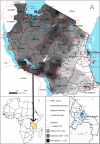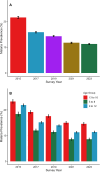Trends in malaria prevalence among school-age children in Mainland Tanzania, 2015-2023: A multilevel survey analysis
- PMID: 40202942
- PMCID: PMC11981166
- DOI: 10.1371/journal.pgph.0004386
Trends in malaria prevalence among school-age children in Mainland Tanzania, 2015-2023: A multilevel survey analysis
Abstract
In high-transmission areas, school-aged children have higher malaria prevalence and contribute significantly to the transmission reservoir. Malaria infections can be asymptomatic or present with symptoms which may contribute to anaemia, severe illness and fatal malaria. This analysis provides trends of malaria prevalence and associated risk factors among school-aged children in mainland Tanzania. Data for this analysis were obtained from nationwide school malaria surveillance conducted every other year from 2015 to 2023. A total of 307,999 school children aged 5-16 years old from 850 public primary schools were tested for malaria infection using rapid diagnostic tests, assessed for malaria control intervention coverage and other malaria-related parameters. A multilevel mixed-effects logistic regression model was used to assess associated risk factors. Overall malaria prevalence was 21.6% (95%CI: 21.3-22.0) in 2015 which progressively decreased to 11.8% (95%CI: 11.5-12.0 p <0.001) in 2021 with no significant change in the overall malaria risk between 2021 and 2023 (AOR 1.32, CI: 0.92-1.81, p=0.08). School children aged between 9-12 years and 13-16 years had 20% higher risk of malaria (95% CI: 1.15-1.25) and 21% higher risk of malaria (95% CI: 1.16-1.27), respectively, compared to those aged between 5-8 years. Geographically, children from the Lake zone had the highest odds of prevalence (AOR: 18.75; 95% CI: 12.91-27.23) compared to the Central zone, and sleeping under an insecticide-treated net demonstrated a protective effect (AOR=0.68, 95%CI: 0.64-0.72, p < 0.001). There was a significant decline in the prevalence of malaria infection across the study period. We presented a countrywide active surveillance data, collected over time and in different settings which are unique and seldom presented. We believe various stakeholders will use our findings and join force to combat malaria not just in Tanzania but, in all malaria endemic countries.
Copyright: This is an open access article, free of all copyright, and may be freely reproduced, distributed, transmitted, modified, built upon, or otherwise used by anyone for any lawful purpose. The work is made available under the Creative Commons CC0 public domain dedication.
Conflict of interest statement
The authors have declared that no competing interest exist.
Figures



References
-
- WHO. World malaria report 2023. Geneva: World Health Organization; 2023. Report No.: Licence: CC BY-NC-SA 3.0 IGO.
-
- Bundy D, Silva N, Horton S, Jamison D, Patton G. Malaria in Middle Childhood and Adolescence. In: Bundy DAP, Silva ND, Horton S, Jamison DT, Patton GC. (Editors). Child and Adolescent Health and Development. 3rd ed. Washington (DC); 2017.
LinkOut - more resources
Full Text Sources
